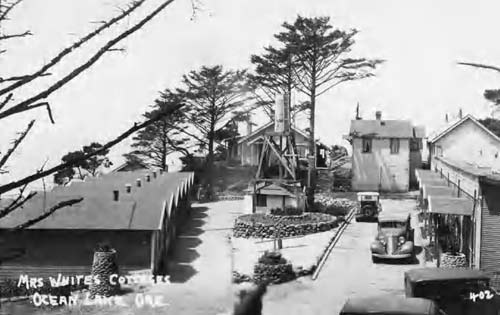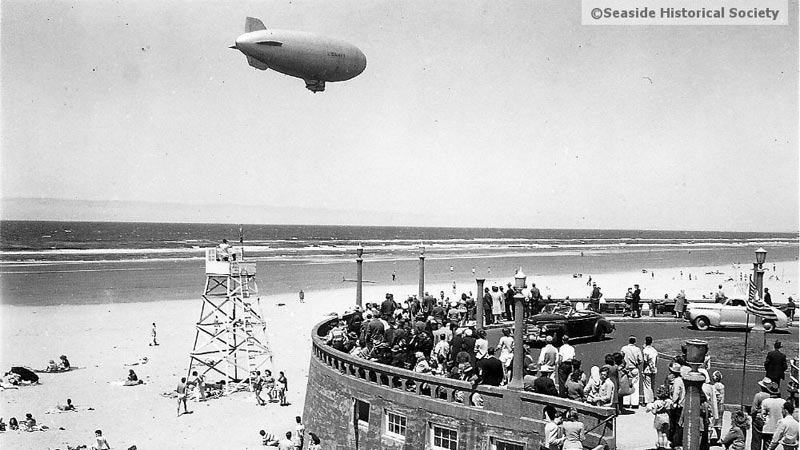Top Eight Most Influential Moments of Oregon Coast History
Published 09/30/20 at 1:41 AM PDT
By Oregon Coast Beach Connection staff

Includes exclusive listings; some specials in winter
In Cannon Beach:
Includes rentals not listed anywhere else
In Manzanita, Wheeler, Rockaway Beach:
Some specials for winter
In Pacific City, Oceanside:
Some specials for winter
In Lincoln City:
Some specials for winter
In Depoe Bay, Gleneden Beach:
Some specials for winter
In Newport:
Look for some specials
In Waldport
Some specials for winter
In Yachats, Florence
Some specials for winter
(Oregon Coast) – Numerous moments and events changed the course of history along this shoreline, but some were truly pivotal. From trains to highways, and from wars to major fires, here are eight of the truly landmark moments that shifted everything. (Above: the "Daddy Train" at Seaside, courtesy Seaside History Museum).
Lewis and Clark. They weren’t the first Europeans to visit this area, but they were the first to really map it out. Lewis and Clark and the Corps of Discovery spent the winter of 1805-06 here, digging deep into the region and – mostly – making friends with the native tribes. It’s a highly influential moment for pioneers but another dreary setback for the people that lived here long before us.
Declaring Oregon Beaches Highways, 1913. As frontiersmen began settling in Oregon and along the coast, the most obvious option for getting anywhere was along the beaches. They acted as the defacto highways then, but in 1913 that became official. That year, Gov. Oswald West created Oregon’s beach highway law, declaring everything on the beaches right up to the high tideline a public highway.
This did two things: it helped ensure public ownership of the beaches for the future and it established a law that was among the first of its kind in the world.
West wasn’t known just for good things: he was an advocate for eugenics at the time and pushed for the arrest of gay men in Portland.
Trains Through the Coast Range. Actual tourism on the Oregon coast didn’t begin until the 1880s, and then it was mostly the northern half. This was only allowed to happen with the advent of trains arriving from the valley. No real roads between the coastline and the valley existed until the earliest years of the 20th century, and even then it was mostly dusty, primitive pathways that turned to complete, unusable mud during the rainy season.
In the Seaside area, trains started passenger service in 1888 and that town became the hub of most coastal tourism. It wasn’t until 1911 that Rockaway Beach had its first train stop. Finally, in 1916, the little town of Marshfield on the southern Oregon coast started getting trainloads of tourists, kicking that area’s travel industry into life. In the ‘40s, Marshfield changed its name to Coos Bay.
Building Highway 101. Before the ‘20s, there was no decent roadway between Oregon coast towns, and each was essentially isolated from the other. However, in 1919 Oregonians voted to construct a major highway along its shoreline, partially out of a need for preparedness after World War I. Thus the project was initially called the Roosevelt Military Highway (which is why Seaside’s portion of 101 is called Roosevelt to this day).
In 1921, work began and finally finished up in the mid ‘30s. The bulk of it – from Brookings to about Wheeler – was constructed by the early ‘30s, but some parts needed to still be connected, resulting in things like the Arch Cape tunnel. During this time, major waterways stood in the way as well, such as at Gold Beach, Coos Bay, Newport and Waldport. Conde McCullough was the man in charge of the highway department then, and also a highly adept bridge engineer. It was he who designed many of the bridges still standing today – with the exception of Waldport’s, which tore down the McCullough bridge decades ago and put up a larger one.
In 1926, it was officially called U.S. 101, then later called the Oregon Coast Highway.

Gov. McCall during a publicity tour of Cannon Beach in 1967
Oregon Beach Bill. There was a time that some of Oregon’s beaches were about to become private.
In the mid ‘60s, a hotel owner in Cannon Beach decided he wanted the chunk of beach in front of his place all to himself – and his guests. He began cordoning it off. Thus began a fight that turned into a piece of legislation called the Oregon Beach Bill. In 1967, with Governor Tom McCall championing the bill, it stood on shaky ground in Salem’s capitol, about to fail. But a series of small publicity stunts went a long way, and suddenly Oregonians were fully behind the bill, which passed on June 7, 1967.
Tillamook Burn. From 1933 to 1951, the Oregon coast was burning. Four different major fires comprised what is called the Tillamook Burn. The first started in 1933 and ate up 350,000 acres of forestland between Washington, Yamhill and Tillamook counties. The second took place in ‘39 and took out 190,000 acres; the third happened in ‘45 and the last one in 1951.
The result was a feeling of being beaten down by many Oregonians, who started to simply believe the area was too prone to fire to be worth it. This began well before the ‘51 and final blaze. But by 1949, other groups – include parts of the timber industry – invested much time, money and energy into reforestation. Utilizing mostly youth, a program of planting seeds began in 1949, lasting until 1972. In that period a million seedlings were planted, resulting in the thick green we now see throughout this part of the north Oregon coast.

From Tents to Motor Lodges. Just about all coastal lodging was in the form of tents from about the 1880s through the 1920’s. One of the first known changes in this was in Lincoln City at the Nelscott Auto Park in the early ‘20s, which had allowed parking of your car next to your tent, but eventually it built little shacks. Here and elsewhere on the coast this caught on, and soon it was little cabins that you could park next to. By the ‘30s, the idea of the motor lodge was born, and from here on out motel-like buildings were created where you could park your rig in front of your room. This idea exploded by the early ‘40s, but so did World War II, which sunk just about all tourism on the coast. However, after the war tents had all but disappeared in favor of sturdier buildings, and even the motor lodge became extinct in favor of motels and hotels.

World War II. The second Great War changed everything for the Oregon coast, especially daily life. Giant dirigibles roamed the skies looking for enemies, troops patrolled the beaches, and everyone living along the coast had to go “lights out” after dark in case of an enemy attack. Fort Stevens was fired on by a Japanese submarine, and some forests on the south coast received a brief bombing by a Japanese plane.
Oregon Coast Hotels in this area - Where to eat - Maps - Virtual Tours
Cannon Beach Lodging
Nehalem Bay Lodgings
Manzanita Hotels, Lodging
Three Capes Lodging
Pacific City Hotels, Lodging
Lincoln City Lodging
Depoe Bay Lodging
Newport Lodging
Waldport Lodging
Yachats Lodging
Oregon Coast Vacation Rentals
Oregon Coast Lodging Specials
More About Oregon Coast hotels, lodging.....
More About Oregon Coast Restaurants, Dining.....
LATEST Related Oregon Coast Articles
Through 2 a.m. likely best, but some lights possible through dawn June 1 - 2. Space weather, astronomy
Rare Sperm Whale Stranding on N. Oregon Coast, Was Hit by Boat
Showing up near Gearhart, it will decompose naturally. Marine sciences
Coast Guard Barque 'America's Tall Ship' Coming to Portland Rose Fest, N. Ore...
Portland events: June 5 - 8; Astoria events June 13 - 15. Weather
Bright and Active Arietids Meteors May Hit Pre-Dawn Hours of Oregon, Washingt...
Look to east hour before sunrise and you may catch a show. Sciences, astronomy, weather
Why Now Could Be a Great Week for Spotting Killer Whales on Oregon Coast - Video
A good dozen documentations around Depoe Bay, Newport, Coos Bay, Bandon, Tillamook. Marine sciences
Summer Road Work, Traffic Issues Along Oregon Coast Include Astoria, Garibald...
Some daylight closures include bridges, OR 22, OR 18, OR 26, more. Travel tips. Seaside, Cannon Beach, Lincoln City. Travel tips
Pacific City Oregon Weather, 7-Day Forecasts, Live Conditions, Radar, Webcams...
Updated Constantly: Pacific City, Tierra Del Mar, Oregon Weather, Cams, Buoy Observations, Tides, Warnings - Alerts
Oregon Coast Has World's Oldest Harbor Seal, Celebrating 50 Years Soon
June 3 at Oregon Coast Aquarium in Newport. Newport events
Back to Oregon Coast
Contact Advertise on BeachConnection.net
All Content, unless otherwise attributed, copyright BeachConnection.net Unauthorized use or publication is not permitted




















































